Every year, the travel media spill barrels of ink claiming this city or that hosts Europe’s best Christmas market. And you know what: They’re all right…because it’s simply impossible to pick the best.
It’s Christmas. And it’s Europe. The snow. The chill nipping at your neck. Hot mulled wine warming your hands. The redolence of grilled meats perfuming a cold night. The regional desserts and holiday delicacies. And the quaint, wooden cabins painted by Christmas lights selling local, handmade tchotchkes and ornaments beneath the watch of a live Christmas tree stretching 30 feet or more into the sky. Vienna, Prague, Strasbourg, Nuremburg, Budapest, London. Honestly, it really doesn’t matter.
Pretty much every city with a Christmas market does a great job each December of turning ancient central squares and medieval Old Towns into a place where you half-expect to find Santa’s elves looking for new design ideas.
So, instead of pointing you to a “best” that doesn’t exist, we’re going to point you toward European Christmas markets that are unheralded gems. They’re still popular, make no mistake. It’s just that they tend to be popular more at a local, in-the-know level since some of them are in secondary and tertiary cities, while others are a couple hours’ drive or train ride from main cities.
Whatever the case, these are fantastic Christmas markets that offer an equally festive, holiday experience. You bathe in the same Old World ambiance. You gobble up the same great local eats and treats. And you shop the same great artisanal crafts. You’re just doing so at a Christmas market that doesn’t get the same level of press as the major cities.
So, we’ve made our list (and we’ve checked it twice; you knew that pun was coming, right?), and we can tell you without a doubt that, amid all the great Christmas markets in Europe, these are some of the smaller, fabulous gems you should visit…
Krakow, Poland
By Jeff D. Opdyke

Though much of Poland was destroyed in the Nazi blitz, Krakow was the base from which the Nazis oversaw the conquered country from the earliest days of World War II. As such, they didn’t bomb the place…which means Krakow’s atmospheric Old Town still reflects 1,000 years of history.
The early-medieval central square, one of the largest in Europe, competes with Prague in terms of ambiance, and its picturesque skyline is defined by the Gothic St. Mary’s Basilica and the 15th century Cloth Hall, Europe’s first covered market and the progenitor of every shopping mall in the world today.
Along with the typical Christmas décor—the wooden stalls, the lights, the Christmas tree—Krakow’s central square is known for its carolers and a particularly Krakovian tradition: The Krakow Christmas Crib contest that begin in 19th century.
Every December, locals compete to build the most orate nativity crib, which are then paraded through the streets and displayed in the square. Some reach heights of more than six feet.
Then there’s the food. Mountains of grilled meat and sausages, smoked cheeses, a particular style of Polish gingerbread… and, of course, there’s mulled wine that the Poles know as Grzaniec Galicyjski. But perhaps the most unique Christmas libation is hot beer typically spiced with raspberry or ginger syrup. It’s better than you think.
Ravenna Gorge, Germany
By Jeff D. Opdyke
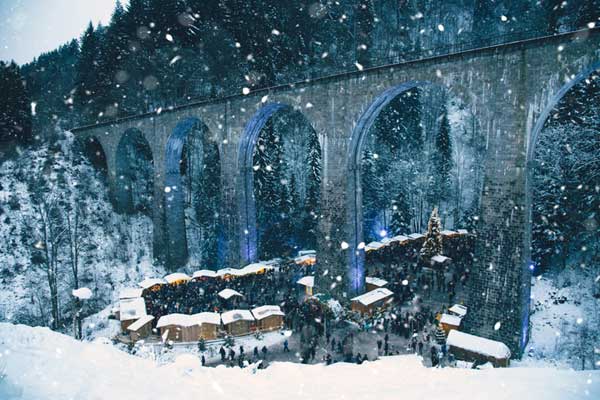
This is quite possibly the single most picturesque Christmas market on the planet. It’s what you imagine the perfect, Christmas village would look like—like, maybe, Santa lives here and you might just bump into him while he’s out fetching a mulled wine for Mrs. Claus.
Located about two hours south of Stuttgart, in Germany’s Black Forest, the Ravenna Gorge market is set, well, in a mountainous gorge covered by a forest of evergreens. And the icing atop is Christmas sugar cookie is that the gorge is traversed by a 130-foot-tall stone, arched railway viaduct…which is up-lit at night for the holidays.
Add a dusting of snow and, honestly, the entire scene looks like something from inside a snow globe.
With just 40 or so wooden huts snaking beneath the viaduct, the Ravenna Gorge market isn’t a large as some of Europe’s major-city Christmas markets. But, then again, no major-city Christmas market has setting you find here.
At Ravenna Gorge, you’ll find everything you need to enjoy a Christmas-market experience—the food, the drink…and stalls selling the regional, artisanal treasure: Black Forest cuckoo clocks. And if nothing else, you can still hit larger Christmas markets in nearby Freiburg or Stuttgart (one of Germany’s most highly rated).
Castello di Limatola, Italy
By Valerie Fortney Schneider
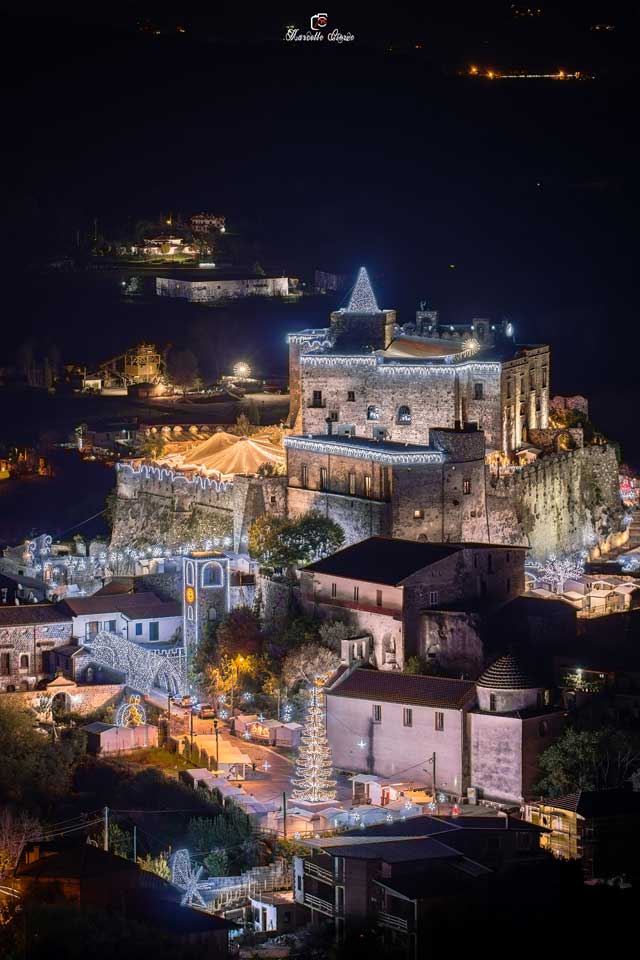
Italy’s largest (and most famous) Christmas markets are in the northern regions—Bolzano, Trento, and Merano and are influenced by the nearby German-Austrian traditions. For a different take though, I like the Castello di Limatola near Caserta (Campania region) where an evocative medieval-era mercato is held in a fairytale castle dating from the 1200s.
Handmade artisan gifts, local food products like the traditional holiday sweet called torrone, locally-crafted nativity scenes, and mulled wine make for a merry market, called Cadeaux al Castello. But add in the knights in armor, medieval-costumed musicians, and flag throwers, and it really sets itself apart from the “usual” Christmas fair. The entire village is decked out with lovely lighting, and the ancient castle and village evoke a magical Old World ambiance.
There are special exhibits, occasional concerts, street performers, and gospel music. There is a bosco incantato (enchanted forest) for the kids, and of course a visit with Babbo Natale (Santa Claus). It’s Italy, so good food is a given, as well. The Castello di Limatola has an excellent restaurant if you really want to make it special.
It runs earlier than many, from November 9th through December 9th. There’s an admission charge, but it’s totally worth it. Limatola is about 20 minutes from Caserta.
Natalis, Lisbon, Portugal
By Tricia Pimental
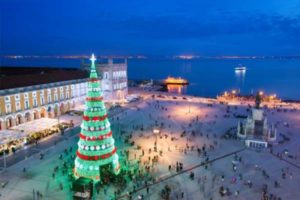
Lisbon is no stranger to fabulous festivals of all kinds, and Natalis (Natal is Christmas in Portuguese) is no exception. There’s something for everyone here, all inside the grand pavilion at Parque das Nações by the Tejo River.
The market-festival features traditions from around the world to explore and taste, including Praça Vegan, for those who want to spare the turkey and still savor the flavors of wintertime foods prepared with Portuguese flair.
The Corredor das Experiências is another favorite, with a cornucopia of workshops to improve your culinary and craft skills. Why not take a cheese-making course or learn the intricacies of whipping up holiday libations? Some of the best chefs in Lisbon will display their world-class talent with cooking shows to stimulate your appetite. Later, leave your diet resolutions until New Year’s and indulge in sweets galore at Praça dos Doces.
Finally, work off those calories at the Diverlandia complex. With more than 30 pieces of equipment and set designs to expand your mind and challenge your body, Diverlandia offers incomparable space for kids of all ages to engage in tactile, physical, and sensory stimulation.
One of the finest Christmas venues in the country, this year Natalis will be held December 4th through 8th. For more, see the website: https://natalis.fil.pt/visitar/.
Colmar, France
By Tuula Rampont
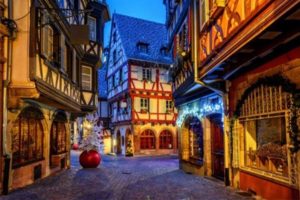
A visit to the beautiful French town of Colmar at Christmastime is the stuff fairytales are made of—for the young and young-at-heart. Voted the number one Christmas market in France in 2017, this Alsatian city, located in the north of France near the German border, transforms itself into a Christmas wonderland.
In old-town Colmar, you’ll find no less than six distinct Christmas markets which sprout up among the city’s cobblestoned streets and early-Renaissance timber buildings. Boasting over 180 stands, each market has its own set of artisans and its own holiday-focused theme. The market on Place Jeanne d’Arc (Joan of Arc square) recreates the atmosphere of a traditional Alsatian village; offering regional favorites like pretzels, cold meats, wine, liqueurs (schnapps), cookies, and Christmas sweets. At the indoor craft market in the historic Koifhus building, about 20 local artists share their creative passions. Here you’ll find potters, glass-makers, wood sculptors, ceramicists, and jewelry makers demonstrating their crafts and selling their “works of art”.
The Gourmet Market on Place de la Cathédrale (cathedral square) is a 100% French affair. Chefs and local restaurant give demonstrations and prepare local dishes for market-goers. Pick up a plate of oysters and sip some Alsatian white wine as the city lights up for the evening and the magic of Christmas is felt all around town.
L’Isle sur la Sorgue, France
By Kevin McGoff

I witnessed Pere Noel’s arrival in L’Isle sur la Sorgue in a style uniquely French. A smartly restored Citroen 2CV, known as a deux chevaux, served as his sleigh. The classic car crossed the square in front of the imposing Collegial Notre Dame des Anges as Pere Noel tossed candy to children while standing in the open sunroof. So began the holiday season in the town also referred to as the “Venice of Provence”.
Well known as a major center for antiques, the charm of L’Isle sur la Sorgue is full on during the Christmas holidays. Elaborate lighting displays are suspended above the streets in the town center. Festive music broadcast throughout the town serenades strollers as they take in the shop windows or stop for a coffee.
The park along the Sorgue River is converted into a Christmas village of “chalets.” These small wooden structures become the holiday season home for participating local shop owners and restaurateurs to open their doors. Artisans from the region provide visitors shopping opportunities as well.
In the evenings, there is live music to accompany a beer, glass of mulled wine, or a coup de champagne and a light meal. Groups of friends gather in the park around an open fire, enjoying good company in a festive setting on crisp winter’s evenings. The Christmas village along the Sorgue is another perk of life in a small town in France.
Salzburg, Austria
By Jeanine Consoli
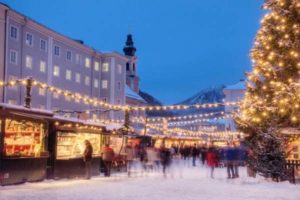
Salzburg, the fourth largest city in Austria, borders Germany at the base of the northern foothills of the Alps. It is less than a two-hour train ride from Munich. The Salzach River divides the city where 12 different bridges link the modern town and “Altstadt” or old town. The Altstadt was named a UNESCO World Heritage site in 1997 is designated as one of the best-preserved city centers. Medieval and Baroque architecture populate Old Town, and the Hohensalzburg Fortress (the biggest fully preserved castle in Central Europe) sits majestically above the center of Salzburg. Climb all the way to the top or take the funicular to get a breathtaking view of the stunning city.
Salzburg has a proud heritage of art and culture, including the honor of being the birthplace of both Wolfgang Amadeus Mozart and the famous Christmas carol, “Silent Night.” Starting on November 21st, one of the oldest markets in Austria (dating back to 15th century) kicks off Advent. One hundred booths and nativity exhibits ring the Residenz Platz (square) and wind around the entrance to the Cathedral of Salzburg. Roasted nuts, traditional sausages, enormous pretzels, and spaetzle (a type of pasta made with fresh eggs) with cheese feed hungry visitors while warm glühwein and punch spiked with rum swirls the air with the spicy smell of cinnamon. It is a perfect antidote against the cold.
As you stroll through the historic market to browse the unusual glass ornaments, artisan God carvings, and woolen knitwear, you will hear festive carols sung in front of the cathedral. What makes the Salzburg Christmas Market special is the 80 different musical programs that take place in front of the cathedral and on the festival stage. Daily events include the reading of Christmas stories, Krampus parades, the market’s own embodiment of the Christ Child, choral performances, and traditional wind music or Turmblasen that is played every Thursday and Saturday from the towers around the Residenz Square. The ringing church bells enhance the festive atmosphere and truly makes it feel like Christmas.
Christkindlemarkt – Nuremberg, Germany
By Jeanine Consoli

Nuremberg, the second-largest city in the German state of Bavaria, was founded in the 11th century. Since the Middle Ages, the Imperial Kaiserburg Castle that sits high above Old Town was one of the most famous palaces of the Holy Roman Empire. It was the designated location for imperial assemblies and sat at the crossroads of several trade routes. Due to its past prominence, Hitler selected Nuremberg as the rally center for the National Socialist Party in the 1930s. The allies bombed Nuremberg during World War II, and 90% of the city was destroyed. The medieval walls and buildings were reduced to rubble but painstakingly reconstructed after the war.
Located halfway between Munich and Frankfurt, the city is easily accessible by train and the Christmas festival, held in Old Town, is a 10-minute walk from the station. Christkindlemarkt is the most significant and best-known Christmas market and dates back to the 16th century. The festival, held on three different squares within Old Town, begins in the Hauptmarkt, the central square in front of the Church of Our Lady. The market is opened two days before the first Sunday of Advent by the Christkind (an angel with golden curls and a golden crown) who climbs to the top of the church to recite a decade’s old poem.
For the next 26 days, you can browse through the 180 wooden stalls built from regional spruce and decorated with fresh greens and lights. The stalls are filled with Lebkuchen (gingerbread that has been made the same way for 600 years) and holiday decorations made from wood, glass, or the traditional Rauschgoldengel (gold foil angels).
Look for the prune men or Zwetschgenmannle, traditional figurines made from dried prunes, walnuts, and figs. Visit the Market of the Sister Cities where you can purchase gifts from all over the world, and the Children’s Christmas Market with an enchanting two-tiered carousel. Taste the Nuremberg sausages that have been world-famous for 700 years. Eat like a local and order a Weckla, three Nuremberg sausages on a crusty roll topped with spicy mustard.
Glasgow, Scotland
By Erin Jones
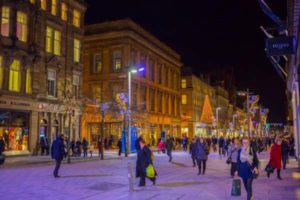
Glasgow is the largest city in Scotland but is sometimes overlooked by travelers in favor of Edinburgh or the Highlands. With its world class Kelvingrove Art museum, and edgy street art covering a myriad of Victorian style buildings, Glasgow is a modern city with Old World character. The locals are friendly and always willing to help with directions or a have friendly chat. And if you find yourself in Glasgow at Christmas time, the market in St. Enoch Square is a delight to the senses and is well worth a wander.
The market opens in early November and ends close to Christmas Day. Although the opening time might feel a little early for some, the festive atmosphere will soon win you over. The market has a German feel with bars and food stalls offering a variety of beer, mulled cider, sausages, and sweet treats. The German style Christmas pyramid or Weihnachtspyramide is what really stands out. Towering above a chalet, it’s comprised of three floors depicting different scenes from the nativity. At night it’s covered in lights and is the centerpiece of the market, beckoning those to take a closer look.
The market is nestled between two of Glasgow’s main shopping streets—Argyle and Buchanan—and provides a more local shopping experience compared to the high street stores in the area. The smell of sausages sizzling on the grill combined with the sweet scent of cider helps fuel your wander through the market. Vendors will beckon you to see their wares in a friendly manner without being overly pushy. The atmosphere is bustling with crowds but family friendly.
The market is open late on weekends and you’ll discover the crowd includes locals along with those who have traveled farther distances to soak up the Christmas atmosphere.

Get Your Free Report on Europe Here:
Learn more about countries in Europe and other countries from around the world in our daily postcard e-letter.
Simply enter your email address below and we'll also send you a FREE report - All the Charm and Romance of Europe…at a Price You Can Afford.
Related Articles
Europe’s Top 5 Affordable Retirement Havens
France Itinerary: A Journey Through Southern France
Schengen Visa: What Countries Are in the Zone?
Upcoming Conferences
The Only 2024 Fast Track Panama Conference
If your dream retirement involves stunning beaches… lush green mountains… a warm climate with no hurricanes… first-rate healthcare… incredible value for money (a couple can live well on $2,200 a month)… and the World’s #1 Retiree Discount Program…
Join our Panama experts and expats in February and discover why Panama could be your perfect paradise.
REGISTER NOW, SEATS LIMITED: EARLY BIRD DISCOUNT HERE


.png)